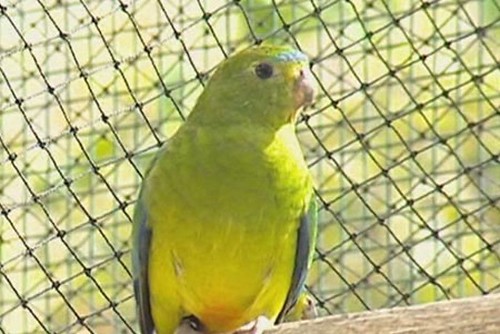 An orange-bellied parrot in captivity.
An orange-bellied parrot in captivity.
The bird is on the brink of extinction with fewer than 70 birds thought to exist in the wild.
About 250 parrots have been bred in captivity as part of a long-term recovery plan for the species.
In November last year, 27 captive bred parrots were released at the bird's only breeding ground, Melaleuca, in Tasmania's south-west.
All captive birds tested negative to the beak and feather disease virus.
Last summer, 19 wild nestlings and one adult tested positive to the often deadly beak and feather virus.
Fourteen of the nestlings are unlikely to have survived the season.
Convener for Birdlife Tasmania, Dr Eric Woehler, said the outbreak of the disease was "perhaps the most significant threat to the long-term existence of the species in the wild".
Right to Information documents provide information on the laboratory testing of the infected wild birds.
The results indicated that the outbreak was genetically different to previous strains of beak and feather disease found in captive birds.
The documents showed the strain was similar to that of the sulphur-crested cockatoo, indicating that the outbreak was most likely sourced from the wild.
A disease action group meeting three months ago did note however that it was highly unlikely but still possible that the "outbreak has come from captivity and that infected birds currently in captivity have the same strain as the virus outbreak in the wild".
"We'd have to defer at least to the Government expertise in terms of the testing but you'd have to ask how often such a transfer could occur," Dr Woehler said.
"The south west isn't particularly good habitat for sulphur-crested cockatoos so you'd have to wonder how often an infected sulphur-crested cockatoo would come in contact with or be able to pass on the virus in some way to the orange-bellied parrots in the south west."
A spokesman for the Department of Primary Industries, Parks, Water and Environment said in a statement the results of testing indicated the disease outbreak was most likely a result of transmission from another species of parrot in the wild.
Plans are underway to transfer more captive bred birds into the wild this breeding season.
The department said the number of birds released would depend on disease and health screening and strict biosecurity measures were in place.
"I understand there are very strict biosecurity measures in place to prevent the transmission of potential diseases from captive-bred birds into the wild and that includes testing for beak and feather disease before the birds are released," Dr Woehler said.
"The last thing we want to see is a disease introduced by the rehabilitation effort and I imagine the Government would have a similar perception."
The department said preparations were underway at the Melaleuca breeding site ahead of the return of the wild birds later this month and during October.
There are plans to install up to 20 nest boxes attached to free-standing poles to allow for better disease management and predator control.
There will also be extra feeding tables installed.
An extra $500,000 has been provided by the Federal Government in response to the beak and feather disease outbreak among wild orange-bellied parrots.